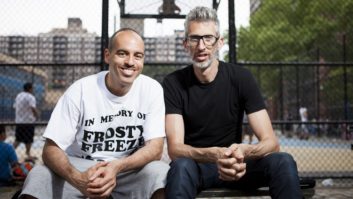2013 NAB Show in Review, Legally Speaking
May 1, 2013 7:00 AM, By Lee Petro
A trip to the NAB Show in Las Vegas is always an adventure. While one gets used to Elvis impersonators and wedding chapels on every corner, the 2013 show had the added intrigue of taxi strikes, threats by a top broadcast network to go pay-only, and the never-ending discussion of television incentive auctions. For those who could not attend or are still suffering from sensory overload, here are a few highlights.
Internet Radio. Several panels discussed the growth of Internet radio services and the drive to get these services included on the dash of automobiles. Deemed to be the new Holy Grail, Internet radio providers are working hard to have car companies include their services on the digital displays for new cars. Currently, these displays contain icons for separate services (i.e., Pandora), but the costs associated with negotiating separate agreements with each auto company and conforming to different technical specifications are enormous. Thus, new platform services are being developed (i.e., Aha) that serve as an intermediary between auto companies and various service providers. These intermediaries may usher a flood of new services into your car, much as Apple’s AppStore launched the invasion of your phone.
The other interesting tidbit is that none of these services have yet to turn a profit. In fact, for services like Pandora, adding subscribers actually causes the company to lose money due to the copyright royalties that must be paid. While they are certainly interested in expanding their subscriber base, how long can these companies continue to operate under the current copyright regime, and are new companies being held back from entering the space due to the copyright fees?
Internet TV. Also discussed was the on-going lawsuit by the television stations in New York against Aereo. Aereo has set up thousands of mini antennas to pull in the over-the-air signal in New York City, and then streams the signal to their subscribers on demand. There is another function that permits the subscriber to record a signal, and then obtain the program at a later time. On April 1, the U.S. Court of Appeals for the Second Circuit denied the preliminary injunction motion by the New York broadcasters and permitted Aereo to continue to provide its service to New York state residents while the court case continues.
The main issue of the case is whether Aereo violates the copyright interests of the broadcasters, who have argued that they are entitled to protection. The decision to deny the request for preliminary injunction did not end the matter, though, as the court will still need to decide the case on the merits. During the NAB Show, the COO for News Corp. stated that if the court permitted Aereo to continue without paying copyright royalties to the broadcasters, they would consider pulling the signal and going to a subscription model.
Compensation to copyright holders for the use of their material is the common thread between these issues. In both cases, the right to deliver content is directly affected by the royalties that must be paid. In the future, these battles over the rights to content, and the associated royalties that must be paid, will come to the forefront as the methods for distribution of content continue to expand.
Incentive Auctions. There were also many discussions associated with the FCC’s plan to auction a portion of the television spectrum for wireless use. As proposed, the auction will involve the voluntary relinquishment of broadcast rights by television licensees (turning in their licenses, and either exiting the business or agreeing to share with another station in the market) in exchange for a portion of the revenue paid by the wireless carriers for the relinquished spectrum.
The auction plan involves a multitude of complicated moving parts, including proper valuation of the television spectrum, determining who gets to volunteer their spectrum, the post-auction band plan, and the repacking of the television stations in the smaller portion of the band. On the outside looking in are the low-power television licensees who do not get to participate in the auction, but face the possibility of losing their spectrum during the repacking process. On the line are the Class A television licensees, who are protected under the auction statute from losing their spectrum, but face increased scrutiny by the FCC’s Media Bureau to ensure they are complying with the Class A rules, or suffer downgrade to the unprotected LPTV status.
While the discussions raised many interesting questions, there was, not surprisingly, a deficit of answers.

Dateline
May 16: Stations in Texas continue to run license renewal post-filing announcements. Stations in Arizona, Idaho, Nevada, New Mexico, Utah and Wyoming continue to run license renewal pre-filing announcements.
June 3: Stations in Arizona, Idaho, Nevada, New Mexico, Utah and Wyoming file License Renewal Application and EEO Program Report, and noncommercial radio stations file Ownership Report (323-E). Commence running license renewal post-filing announcements, continuing on June 16, and July 1 and 16.
Petro is of counsel at Drinker Biddle & Reath, LLP. Email: [email protected].
May 2013
WKSU designs to handle noise, wireless site connectivity, Field Reports from Deva and Worldcast APT, 20 years of Radio magazine and some NAB review….











